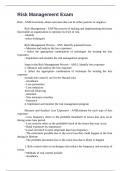Exam (elaborations)
Risk Management Exam questions and answers 2024/2025
- Course
- Institution
Risk Management Exam questions and answers 2024/2025. Risk management is the process by which we try to manage the uncertainty surrounding the objectives. The purpose of the risk management process is to ensure that these objectives are attained.
[Show more]



